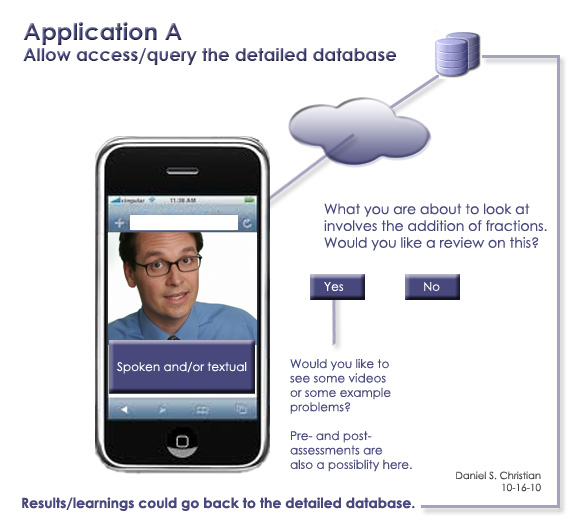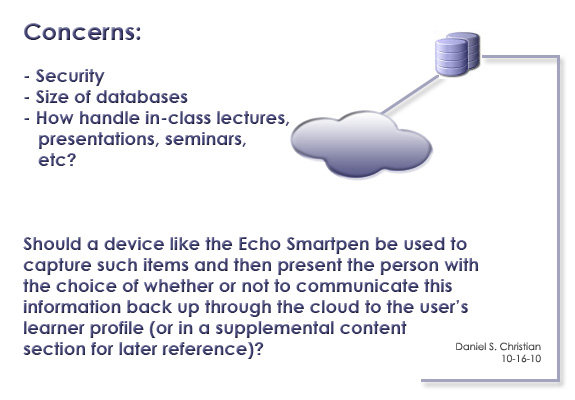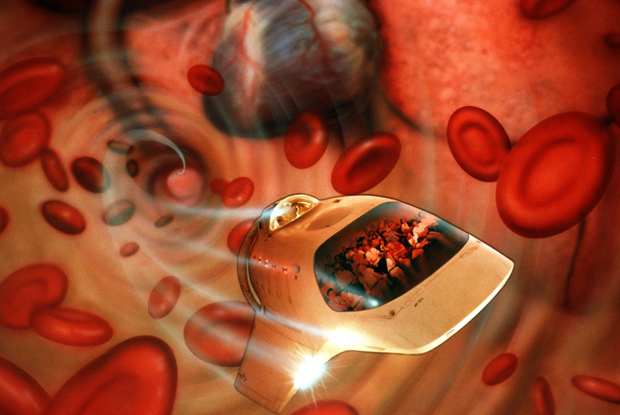
.

.

.

Augmented reality and mobile learning — from interactyx.com by Jeff Roth
Let me pose this scenario:
Every day, you walk down the same street. You walk past the buildings, see the crowds and yawn. But on this day, you decide to use your smartphone and look down on the screen. At that moment, you see animation, tweets from people in the area, and you can respond. Interactivity meets reality. Social meets real time visibility. Engagement, enlightenment and excitement in an instance.
You wonder to yourself, can this work in the e-learning world? Specifically, m-learning? Can an app for the smartphone superimpose learning in a location or locations? Would it be possible to create a 3D environment in a real environment with people interacting? If yes, what would it be called?
Augmented Reality and it is happening as we speak…
Homework Rescue offers online resource — from savagepacer.com by Keighla Schmidt
There’s Google chat, Facebook chat, AOL instant messaging, Yahoo! messenger and the list goes on when it comes to instant help at your fingertips. Add teenagers into the mix and consider the combo peanut butter and jelly.
And when it’s time to do homework at the Braun house in Savage, mom Sandy has no problem with her Prior Lake High School children Jake, a freshman, and Leigh, a sophomore, going online and chatting.
As long as they’re logged onto Homework Rescue, a free, online live one-on-one instant messaging tutor offered through the library and can be accessed remotely.
Homework Rescue is available at www.scott.lib.mn.us under the online references collection daily from 1-11 p.m. for free by using a library identification number. About 100 metro area libraries are part of the Metropolitan Library Services Agency (MELSA), which financially supports the program.
Creating a culture of innovation — from Gallup Management Journal by Jason Krieger
In the “new normal,” fostering innovation will be a driver of organic growth. Organizations must have these six key steps in place.
Also see:
Reinventing management for a networked world — one of topics/presentations at Educause 2010
From DSC:
The following summary of this presentation is a powerful message that I’m looking forward to hearing (emphasis mine):
Over the past decade, the Internet has had a profound impact on just about every organization around the world. It has enabled dramatic efficiency gains in core processes and has radically changed service delivery in industries as diverse as education, financial services, publishing, and entertainment.
However, the greatest impact of the Internet is likely to come over the next decade as it starts to reshape the traditional management processes and structures that are used to run large-scale institutions. The management practices found in most organizations today trace their roots back to the Industrial Age or to medieval religious orders. While this model was well suited to a world requiring conformance and discipline, it is woefully inadequate and even toxic in today’s world of accelerating change.
To thrive in the years ahead, every organization must become as nimble as change itself—a challenge that will require a fundamental rewiring of our tradition-bound management principles and practices.
Unlike most organizations, the web is a cauldron of innovation; it is extraordinarily malleable and highly adaptable. In these respects, it already exhibits exactly those qualities that will be most critical to organizational success in the years to come.
That’s why the management model of every organization will need to be rebuilt on the fundamental values of the web: freedom, openness, transparency, collaboration, flexibility, and meritocracy. In this provocative and practical presentation, Gary Hamel will lay out a blueprint for “Management 2.0” and outline the steps you can take to help your organization to become as adaptable as the times demand.
While looking at the video for Sonos Controller for the iPad, I wondered…what if we could replace the selection below — i.e. the word music with the words “educational providers” — and then control which room received which signal/content?
Wow…talk about a home dedicated to learning! 🙂
.
.
Also see:
.
.
Addendums:
10-5-10– from Google announces TV deals with HBO, NBA, others
“One of our goals with Google TV is to finally open up the living room and enable new innovation from content creators, programmers, developers and advertisers,” Ambarish Kenghe, developer product manager for Google TV, said in the post.
University, IBM to open unique high school in NYC — By The Associated Press
The City University of New York and IBM will open a unique school that merges high school with two years of college, allowing students to earn an associate’s degree, Mayor Michael Bloomberg said Monday in announcing a series of ambitious educational initiatives.
Those students will be “first in line for a job at IBM,” Bloomberg said in his announcement, made on MSNBC.
The city also will move to a rating system this year designed to ensure teacher tenure is linked to classroom performance. Only teachers rated “effective” or “highly effective” will be awarded lifetime job…
USC Brings Together Filmmakers, Engineers, Doctors for Its New Body Computing Center — from FastCompany.com by Allisa Walker
